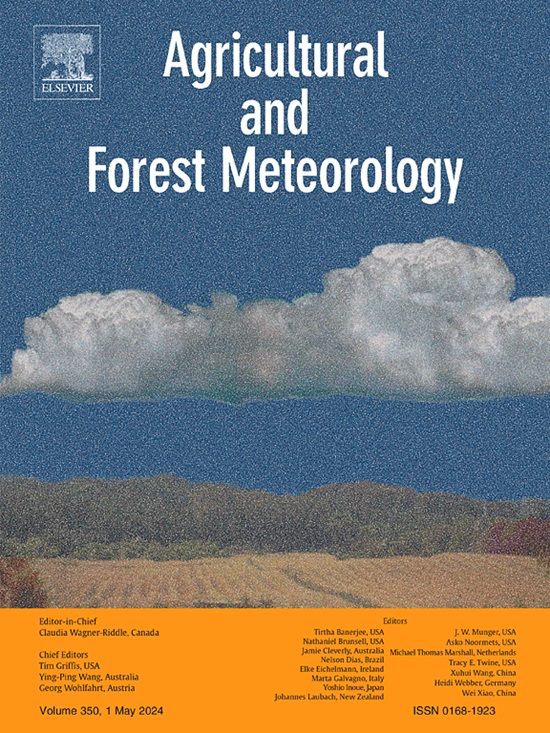Wheat leaf area index retrieval from drone-derived hyperspectral and LiDAR imagery using machine learning algorithms
IF 5.7
1区 农林科学
Q1 AGRONOMY
引用次数: 0
Abstract
Leaf Area Index (LAI) is a key parameter that reflects canopy structure and influences photosynthetic activity. Traditional remote sensing methods using spectral indices usually struggle with saturation at LAI > 3.0 m2 m–2 in crop fields. Light detection and ranging (LiDAR) systems offer a solution by capturing detailed canopy structures.
This study used drone-based LiDAR and hyperspectral imagery to predict LAI across 60 plots in five wheat fields in Israel. Field LAI, assessed using a handheld optical sensor, ranged from 0.25 to 7.7 m2 m–2. LiDAR-derived metrics, including height, gap fraction, and canopy volume features, were combined with spectral indices for LAI prediction. These metrics were used in simple linear regression (SLR) and five machine learning (ML) models: artificial neural network (ANN), random forest, ridge regression, relevance vector machine, and extreme gradient boosting. Shapley’s additive explanations identified key predictive features.
Results show that ML models significantly improved prediction performance (R2 = 0.59–0.90) compared to single metric SLR models (R2 = 0.09–0.67). Combined LiDAR-spectral models outperformed spectral- and LiDAR-only models. ANN achieved the best results, with a mean R2 of 0.90, normalized RMSE of 6 %, and residual prediction deviation (RPD) score of 3.34, accurately predicting LAI up to 5.5 m2 m–2. LiDAR alone or in combination with spectral metrics improved LAI predictions. While some spectral metrics ranked high, LiDAR-derived metrics, particularly canopy volume-related, consistently emerged among the most important features, with gap fraction and height metrics also contributing to the models. This study demonstrates the efficacy of drone-based LiDAR for non-destructively predicting LAI in wheat fields, offering a valuable tool for crop model calibration and evaluation and addressing the challenge of scaling from leaf to canopy.
利用机器学习算法从无人机衍生的高光谱和激光雷达图像中检索小麦叶面积指数
叶面积指数(LAI)是反映冠层结构和影响光合活性的关键参数。使用光谱指数的传统遥感方法通常在LAI >;耕地面积3.0 m2 - 2。光探测和测距(LiDAR)系统通过捕获详细的树冠结构提供了一种解决方案。这项研究使用基于无人机的激光雷达和高光谱图像来预测以色列5个麦田60个地块的LAI。使用手持式光学传感器评估的现场LAI范围为0.25至7.7 m2 - 2。激光雷达衍生的指标,包括高度、间隙分数和冠层体积特征,与光谱指数相结合,用于LAI预测。这些指标被用于简单线性回归(SLR)和五种机器学习(ML)模型:人工神经网络(ANN)、随机森林、脊回归、相关向量机和极端梯度增强。沙普利的加法解释确定了关键的预测特征。结果表明,与单度量SLR模型(R2 = 0.09-0.67)相比,ML模型显著提高了预测性能(R2 = 0.59-0.90)。激光雷达-光谱组合模型优于光谱模型和激光雷达模型。人工神经网络的结果最好,平均R2为0.90,归一化RMSE为6%,残差预测偏差(RPD)评分为3.34,准确预测LAI可达5.5 m2 m-2。单独使用激光雷达或与光谱指标相结合可提高LAI预测。虽然一些光谱指标排名较高,但激光雷达衍生的指标,特别是与冠层体积相关的指标,始终是最重要的特征之一,间隙分数和高度指标也有助于模型。该研究证明了基于无人机的激光雷达在非破坏性预测麦田LAI方面的有效性,为作物模型校准和评估提供了有价值的工具,并解决了从叶片到冠层的缩放挑战。
本文章由计算机程序翻译,如有差异,请以英文原文为准。
求助全文
约1分钟内获得全文
求助全文
来源期刊
CiteScore
10.30
自引率
9.70%
发文量
415
审稿时长
69 days
期刊介绍:
Agricultural and Forest Meteorology is an international journal for the publication of original articles and reviews on the inter-relationship between meteorology, agriculture, forestry, and natural ecosystems. Emphasis is on basic and applied scientific research relevant to practical problems in the field of plant and soil sciences, ecology and biogeochemistry as affected by weather as well as climate variability and change. Theoretical models should be tested against experimental data. Articles must appeal to an international audience. Special issues devoted to single topics are also published.
Typical topics include canopy micrometeorology (e.g. canopy radiation transfer, turbulence near the ground, evapotranspiration, energy balance, fluxes of trace gases), micrometeorological instrumentation (e.g., sensors for trace gases, flux measurement instruments, radiation measurement techniques), aerobiology (e.g. the dispersion of pollen, spores, insects and pesticides), biometeorology (e.g. the effect of weather and climate on plant distribution, crop yield, water-use efficiency, and plant phenology), forest-fire/weather interactions, and feedbacks from vegetation to weather and the climate system.

 求助内容:
求助内容: 应助结果提醒方式:
应助结果提醒方式:


